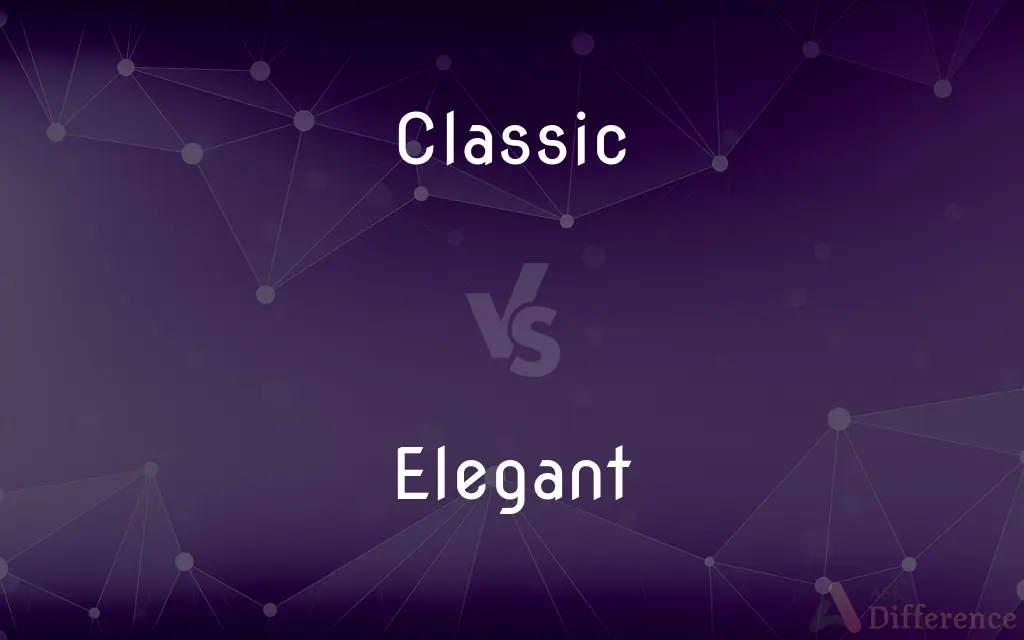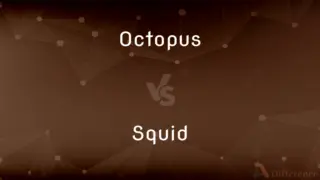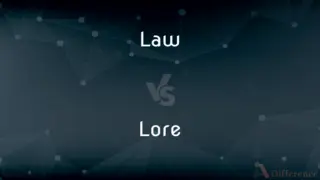Classic vs. Elegant — What's the Difference?
Edited by Tayyaba Rehman — By Urooj Arif — Updated on February 27, 2024
Classic refers to a style or design that remains fashionable and appealing over time, noted for its simplicity, quality, and enduring appeal. Elegant, however, emphasizes grace, sophistication, and beauty, often associated with minimalism and fine detail.

Difference Between Classic and Elegant
Table of Contents
ADVERTISEMENT
Key Differences
Classic style is timeless, transcending trends to embody a look that remains stylish and acceptable across decades. It is characterized by simplicity, functionality, and a nod to traditional values and aesthetic. Elegant style, while it can share some characteristics with classic designs, focuses more on the beauty and sophistication of an object or look.
Classic designs are often understated, prioritizing quality and durability over fleeting fashion trends, making them appealing to a wide audience over long periods. Elegance is often achieved through refined taste, gracefulness, and the use of high-quality materials. It can be minimalist or detailed, but it always conveys a sense of luxury and fine craftsmanship.
The intersection of classic and elegant styles can be found in objects or designs that have stood the test of time while also exuding sophistication and high-quality aesthetics. However, not all classic designs are inherently elegant, and not all elegant designs are necessarily classic. Classic emphasizes timeless appeal and quality, while elegance is more about the immediate impact of beauty and sophistication.
Classic designs prioritize functionality alongside aesthetics, ensuring that an item is not only beautiful but also practical and durable. Elegant designs, while they may also be functional, often place a higher emphasis on form and appearance, sometimes prioritizing visual appeal over practicality.
The choice between classic and elegant styles often depends on personal preference, the intended use, and the context in which an item or design is being considered. While classic choices might be preferred for their longevity and broad appeal, elegant options are selected for their beauty, sophistication, and the statement they make.
ADVERTISEMENT
Comparison Chart
Definition
Timeless style known for simplicity and quality.
Style that emphasizes grace and sophistication.
Focus
Durability, functionality, broad appeal.
Beauty, fine detail, luxury.
Characteristics
Understated, traditional, enduring.
Refined, minimalist or detailed, luxurious.
Appeal
Broad, across decades.
Immediate, often associated with fine taste.
Practicality vs. Aesthetics
Balances both, with a lean towards practicality.
Often prioritizes aesthetics over practicality.
Compare with Definitions
Classic
Vintage cars that never go out of style.
The classic Mustang remains a symbol of enduring automotive excellence.
Elegant
Interior design with a minimalist, refined look.
The elegant living room boasted clean lines and luxurious materials.
Classic
Literature that remains relevant over time.
Shakespeare's works are considered classic due to their universal themes.
Elegant
A sleek, sophisticated outfit.
His elegant suit was tailored to perfection, exuding sophistication.
Classic
Traditional architecture with enduring value.
The classic colonial house has remained popular for its functionality and aesthetic.
Elegant
Jewelry that emphasizes grace and beauty.
Her elegant necklace added a touch of luxury to her ensemble.
Classic
Music that transcends generations.
Beethoven’s symphonies are hailed as classic masterpieces of the musical world.
Elegant
Technological products with sleek designs.
The latest smartphone model is both elegant and powerful.
Classic
A little black dress known for its timeless appeal.
Her classic dress choice made her stand out without following passing trends.
Elegant
Writing that is graceful and clear.
Her speech was elegant, captivating the audience with its eloquence.
Classic
A classic is an outstanding example of a particular style; something of lasting worth or with a timeless quality; of the first or highest quality, class, or rank – something that exemplifies its class. The word can be an adjective (a classic car) or a noun (a classic of English literature).
Elegant
Characterized by or exhibiting refined, tasteful beauty of manner, form, or style.
Classic
Serving as the established model or standard
A classic example of colonial architecture.
Elegant
Characterised by or exhibiting elegance.
Classic
Having lasting significance or worth; enduring.
Elegant
Characterised by minimalism and intuitiveness while preserving exactness and precision.
An elegant solution
Classic
Adhering or conforming to established standards and principles
A classic piece of research.
Classic
A work of acknowledged excellence and authority, or its author; - originally used of Greek and Latin works or authors, but now applied to authors and works of a like character in any language.
In is once raised him to the rank of a legitimate English classic.
Classic
A creation of the highest excellence
Classic
An artist who has created classic works
Common Curiosities
How does one achieve an elegant look?
Through careful selection of refined, high-quality pieces that emphasize grace and fine detail.
Can a design be both classic and elegant?
Yes, many designs combine timeless appeal with sophistication, embodying both classic and elegant qualities.
How do trends affect classic and elegant styles?
Classic styles are less influenced by trends, maintaining appeal over time, while elegance can be trend-sensitive but prioritizes timeless beauty.
How do cultural perceptions of classic and elegant differ?
Cultural backgrounds can influence what is considered classic or elegant, reflecting local tastes and traditions.
Can affordability align with classic or elegant styles?
Yes, while elegant items often suggest luxury, both classic and elegant styles can be achieved at various price points.
Are classic styles always old-fashioned?
Not necessarily; classic styles are timeless and maintain appeal without being outdated.
How do personal values influence preferences for classic or elegant styles?
Personal values around sustainability, quality, and aesthetics can drive the preference for one style over the other.
Why choose classic over elegant, or vice versa?
Choice depends on personal preference, intended longevity, and the context—classic for enduring appeal, elegant for sophistication.
Can modern designs be considered classic or elegant?
Modern designs can be considered elegant and may become classic over time if they retain their appeal.
Is elegance only about visual appeal?
Primarily, but it also involves the quality and refinement of materials and craftsmanship.
How do classic and elegant styles influence fashion?
They provide foundational elements that guide designers in creating timeless and sophisticated collections.
Is sustainability a factor in classic and elegant designs?
Sustainability can be a key aspect, especially in classic designs that prioritize durability and timeless appeal.
Can technology products be classic or elegant?
Yes, technology products can embody elegant design and become classic as they set standards for aesthetics and functionality.
How do classic and elegant styles impact home decor?
They influence choices in furniture, layout, and decor items, balancing aesthetics with longevity and sophistication.
What role does color play in classic and elegant designs?
Color can significantly impact the perception of design, with classic styles often favoring neutrals and elegance embracing both bold and subtle hues for sophistication.
Share Your Discovery

Previous Comparison
Octopus vs. Squid
Next Comparison
Law vs. LoreAuthor Spotlight
Written by
Urooj ArifUrooj is a skilled content writer at Ask Difference, known for her exceptional ability to simplify complex topics into engaging and informative content. With a passion for research and a flair for clear, concise writing, she consistently delivers articles that resonate with our diverse audience.
Edited by
Tayyaba RehmanTayyaba Rehman is a distinguished writer, currently serving as a primary contributor to askdifference.com. As a researcher in semantics and etymology, Tayyaba's passion for the complexity of languages and their distinctions has found a perfect home on the platform. Tayyaba delves into the intricacies of language, distinguishing between commonly confused words and phrases, thereby providing clarity for readers worldwide.
















































